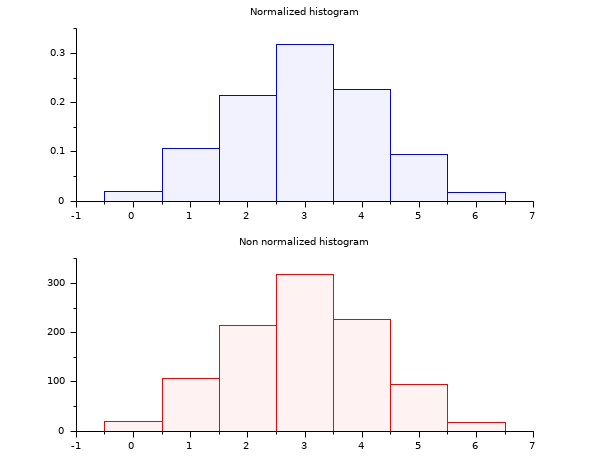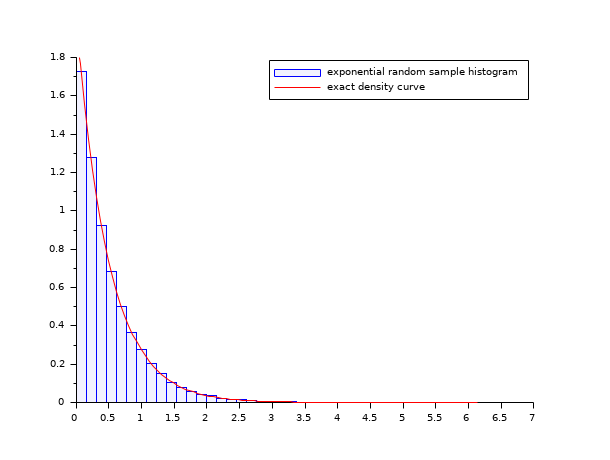Please note that the recommended version of Scilab is 2026.0.0. This page might be outdated.
See the recommended documentation of this function
histc
computes an histogram
Syntax
h = histc(n, data) h = histc(x, data) h = histc(.., normalization)
Arguments
- n
positive integer (number of classes)
- x
increasing vector defining the classes (
xmay have at least 2 components)- data
vector (data to be analysed)
- h
If
normalizationis %T: Probability densities on the bins defined bynorx, such that the bins areas are proportionnal to their populations.If
normalizationis %F: Numbers of elements in the bins.
- normalization
scalar boolean (default = %T), setting the type of output (see
h).
Description
This function computes a histogram of the data vector using the
classes x. When the number n of classes is provided
instead of x, the classes are chosen equally spaced and
x(1) = min(data) < x(2) = x(1) + dx < ... < x(n+1) = max(data)
with dx = (x(n+1)-x(1))/n.
The classes are defined by C1 = [x(1), x(2)] and Ci = ( x(i), x(i+1)] for i >= 2.
Noting Nmax the total number of data (Nmax = length(data))
and Ni the number of data components falling in
Ci, the value of the histogram for x in
Ci is equal to Ni/(Nmax (x(i+1)-x(i))) when
"normalized" is selected and else, simply equal to Ni.
When normalization occurs the histogram verifies:

when x(1)<=min(data) and max(data) <= x(n+1)
Examples
- Example #1: variations around a histogram of a gaussian random sample
// The gaussian random sample d = rand(1, 10000, 'normal'); h = histc(20, d, normalization=%f); sum(h) // = 10000 // We use histplot to show a graphic representation clf(); histplot(20, d, normalization=%f); // Normalized histogram (probability density) h = histc(20, d); dx = (max(d)-min(d))/20; sum(h)*dx // = 1 clf(); histplot(20, d);

- Example #2: histogram of a binomial (B(6,0.5)) random sample
d = grand(1000,1,"bin", 6, 0.5); c = linspace(-0.5,6.5,8); clf() subplot(2,1,1) h = histc(c, d); histplot(c, d, style=2); xtitle(_("Normalized histogram")) subplot(2,1,2) h = histc(c, d, normalization=%f); histplot(c, d, normalization=%f, style=5); xtitle(_("Non normalized histogram"))

- Example #3: histogram of an exponential random sample
lambda = 2; X = grand(100000,1,"exp", 1/lambda); Xmax = max(X); h = histc(40, X); clf() histplot(40, X, style=2); x = linspace(0, max(Xmax), 100)'; plot2d(x, lambda*exp(-lambda*x), strf="000", style=5) legend([_("exponential random sample histogram") _("exact density curve")]);

- Example #4: the frequency polygon chart and the histogram of a gaussian random sample
n = 10; data = rand(1, 1000, "normal"); h = histc(n, data); clf(), histplot(n, data, style=12, polygon=%t); legend([_("normalized histogram") _("frequency polygon chart")], "lower_caption");

See also
History
| Version | Description |
| 5.5.0 | Introduction |
| Report an issue | ||
| << covar | Descriptive Statistics | median >> |